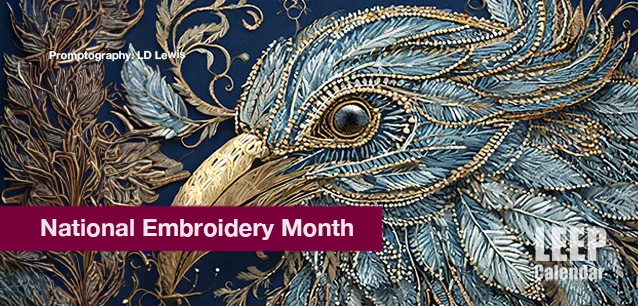 AD
AD
Today is: November 23
Scroll to explore events active on this date.
LEEP INK FEATURES

August is Appropos
A toddler playing in the fountain at a park in Santa Fe, New Mexico—Photo LD Lewis. In August, we live through the Dog Days of Summer. It's hot and often humid, and those ...

September is Sassy
Can you hear that sigh of relief from parents worldwide? Yes! September marks the return of students to school, a global phenomenon. Preparations for the ACT and SATs begin earnestly for ...

OOH LA LA, October
October is the busiest month for events, with 5% more happening than in May, the second most eventful month. Sailing enthusiasts will be glued to the finals of this year's Am...
About National Embroidery Month
Culture & Art , Retail
United States
Ends: Feb 28, 2025
DESCRIPTION:
National Embroidery Month offers a platform for enthusiasts and artisans to showcase their skills, share techniques, and keep the rich embroidery traditions alive. Workshops, exhibitions, and social media challenges encourage participation from both novices and experts, fostering a sense of community and continuity in this historic art form. It is a time for reflection on the embroidery journey, from its humble beginnings to its current status as a celebrated and enduring craft.
Embroidery dates back to the Cro-Magnon period, approximately 30,000 BC. Fossilized remains hint at decorative stitching on animal skins. However, it was in ancient China, around 3500 BC, when silk thread, pearls, and precious stones began embellishing the garments of the elite.
As the centuries passed, embroidery evolved, traveling along the Silk Road. The Islamic world embraced it with intricate geometric and floral designs. By the medieval period, Europe had adopted embroidery, making it a symbol of status and wealth, with the famous Bayeux Tapestry, created in the 11th century, being a testament to its significance in storytelling and art.
The Renaissance further elevated embroidery, introducing new techniques and materials, such as gold and silver threads. Embroidery became a craft and an art form, with schools dedicated to teaching the skill to young women, who used it to demonstrate their refinement and skill.
The Industrial Revolution in the 19th century brought significant changes. The invention of the embroidery machine in 1828 by Josue Heilmann marked a pivotal moment, democratizing the art and making it more accessible. Hand embroidery, once a necessity, became a hobby.
The 21st century has seen a resurgence of interest in hand embroidery. National Embroidery Mont honors this ancient craft within the DIY and craft cultures throughout the world.
VIDEOS
SUPPORTING DOCUMENTS
Currently, this event does not have supporting documents.
ADDITIONAL IMAGES
Currently, this event does not have supporting images.
Where would you like to go now?
 AD
AD


/footer-logo.svg)
